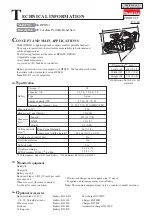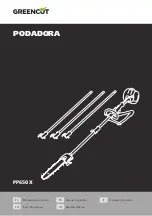
Model G0568/G0569 (Mfd. Since 10/11)
-39-
Basic Functions of a Bandsaw
A properly adjusted bandsaw can be safer to
operate than most other saws and performs many
types of cuts with ease and accuracy. It is capable
of performing the following types of cuts:
Straight Cuts
•
Miters
•
Angles
•
Compound Angles
•
Resawing
•
Ripping
•
Crosscutting
Irregular Cuts
•
Simple and Complex Curves
•
Duplicate Parts
•
Circles
•
Beveled Curves
Basic Cutting Tips
Here are some basic tips to follow when oper-
ating the bandsaw:
•
Replace, sharpen, and clean blades often
for best performance. Check guides, ten-
sion, and alignment settings periodically and
adjust when necessary to keep the saw run-
ning in top condition.
•
Use light and even pressure while cutting.
Light feeding pressure makes it easier to cut
straight and prevents undue friction or strain
on the bandsaw components and the blade.
•
Avoid twisting the blade when cutting around
tight corners. Allow the blade to saw its way
around the corners. Always use relief cuts
when possible.
•
Misusing the saw or using incorrect tech-
niques (e.g. twisting the blade with the
workpiece, incorrect feed rate, etc.) is unsafe
and results in poor cuts.
Workpiece
Inspection
Some workpieces are not safe to cut or may
require modification before they are safe to cut.
Before cutting, inspect all workpieces for the
following:
•
Material Type: This machine is intended for
cutting natural and man-made wood prod-
ucts, laminate covered wood products, and
some plastics. Cutting drywall or cementious
backer board creates extremely fine dust
and may reduce the life of the bearings. This
machine is NOT designed to cut metal, glass,
stone, tile, etc.; cutting these materials with a
bandsaw may lead to injury.
•
Foreign Objects: Nails, staples, dirt, rocks
and other foreign objects are often embed-
ded in wood. While cutting, these objects
can become dislodged and hit the operator,
cause kickback, or break the blade, which
might then fly apart. Always visually inspect
your workpiece for these items. If they can't
be removed, DO NOT cut the workpiece.
•
Large/Loose Knots: Loose knots can
become dislodged during the cutting opera-
tion. Large knots can cause kickback and
machine damage. Choose workpieces that
do not have large/loose knots or plan ahead
to avoid cutting through them.
•
Wet or "Green" Stock: Cutting wood with a
moisture content over 20% causes unneces-
sary wear on the blades, increases the risk of
kickback, and yields poor results.
•
Excessive Warping: Workpieces with exces-
sive cupping, bowing, or twisting are danger-
ous to cut because they are unstable and
often unpredictable when being cut. DO NOT
use workpieces with these characteristics!
•
Minor Warping: Workpieces with slight cup-
ping can be safely supported if the cupped
side is facing the table or the fence. On
the contrary, a workpiece supported on the
bowed side will rock during a cut and could
cause kickback or severe injury.
Содержание G0568
Страница 80: ......
















































